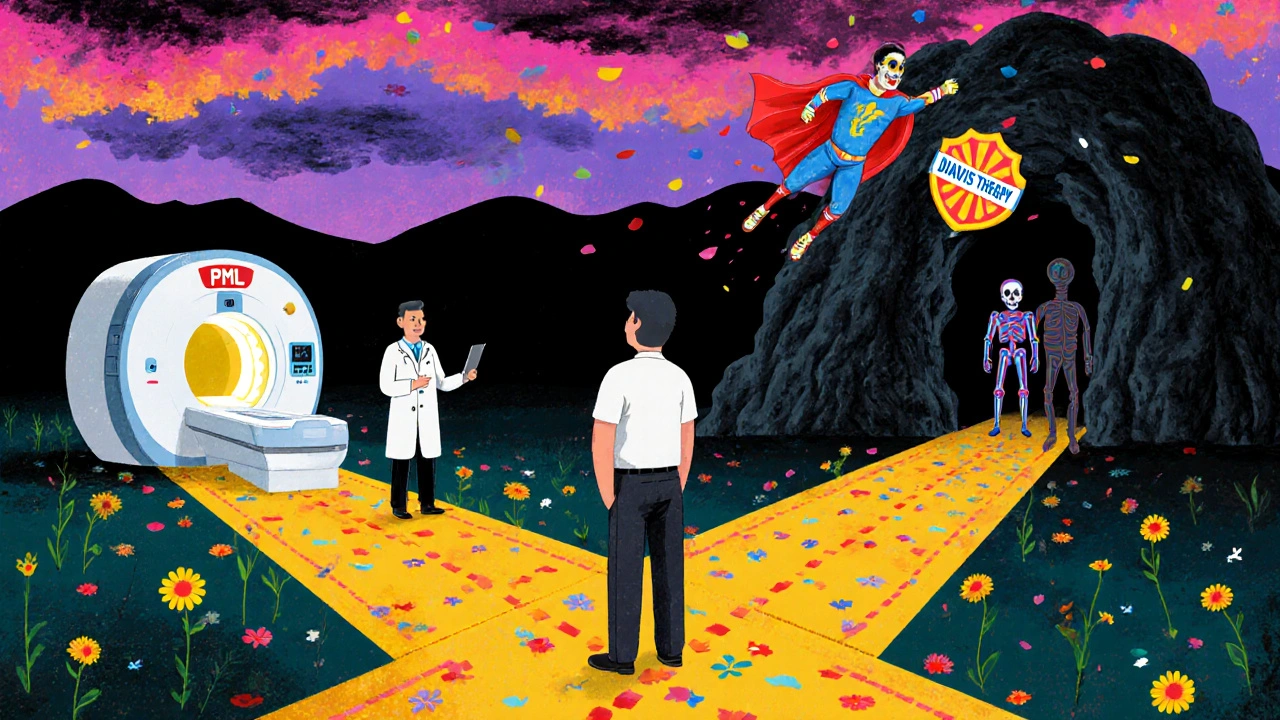PML Risk Assessment Calculator
Personal Risk Assessment
What is Progressive Multifocal Leukoencephalopathy (PML)?
PML is a rare but deadly brain disease caused by the JC virus. Most people carry this virus without knowing it - about 50 to 70% of adults have been exposed. In healthy people, the immune system keeps it locked down. But when your immune system is weakened, especially by certain medications, the virus can wake up, attack the protective coating around nerve cells in your brain, and cause serious damage.
This isn’t just a theoretical risk. Since the 1950s, doctors have seen PML pop up in people with advanced HIV, organ transplant recipients, and those on powerful immunosuppressants. The disease doesn’t come on suddenly. It creeps in with subtle signs: trouble speaking clearly, weakness on one side of the body, blurry vision, or sudden clumsiness. By the time these symptoms are obvious, the damage is often already advanced.
Why Do Immunosuppressants Trigger PML?
Immunosuppressants are designed to calm down the immune system - and that’s exactly what makes them dangerous for PML risk. Drugs like natalizumab (Tysabri), fingolimod (Gilenya), and rituximab (Rituxan) don’t just reduce inflammation. They block specific immune cells from doing their job. For patients with multiple sclerosis or Crohn’s disease, that’s helpful. But it also removes the guardrails that keep the JC virus in check.
It’s not just the drug itself. The biggest risk comes from combinations. If you’ve taken another immunosuppressant - like azathioprine, methotrexate, or mitoxantrone - before starting natalizumab, your risk jumps by 2.5 times. That’s not a small bump. It’s a red flag. The FDA now requires doctors to ask: “Have you ever taken another immune-suppressing drug?” before prescribing natalizumab.
Which Drugs Carry the Highest PML Risk?
Not all immunosuppressants are created equal when it comes to PML. Here’s what the data shows:
| Drug | Typical Use | PML Risk (per 1,000 patients) | Key Risk Factors |
|---|---|---|---|
| Natalizumab (Tysabri) | Multiple sclerosis, Crohn’s | 4.1 (in high-risk group) | JC virus+, prior immunosuppressant, >24 months use |
| Rituximab (Rituxan) | Lymphoma, autoimmune diseases | 0.8 | Long-term use, low B-cell count |
| Fingolimod (Gilenya) | Multiple sclerosis | 0.4 | Use >2 years, lymphopenia |
| Dimethyl fumarate (Tecfidera) | Multiple sclerosis | 0.2 | Prolonged lymphopenia |
| Azathioprine | Autoimmune, transplant | 0.03 | Combined with other immunosuppressants |
| Interferon beta / Glatiramer acetate | Multiple sclerosis | 0 (no confirmed cases) | None identified |
Natalizumab stands out. It’s the most dangerous in terms of PML risk - but only under specific conditions. If you’re JC virus negative, have never taken another immunosuppressant, and have been on it less than two years, your risk is under 0.1%. But stack those risk factors together - and your odds jump dramatically.

How Do Doctors Detect PML Early?
Early detection saves lives. But PML is sneaky. Its symptoms look a lot like a relapse of multiple sclerosis or worsening Crohn’s disease. That’s why doctors rely on three tools:
- JC virus antibody test - This blood test checks if you’ve been exposed to the virus. A positive result doesn’t mean you’ll get PML, but it means you’re at risk. A negative result doesn’t guarantee safety - about 2-3% of people test false-negative.
- JC virus antibody index - For patients on natalizumab, this more detailed test measures how strong the immune response is. If your index is above 1.5, your risk after 4 years of treatment hits nearly 11%. Below 0.9? Less than 0.1%.
- Brain MRI scans - Every 3 to 6 months, patients on high-risk drugs get an MRI. Special sequences can spot early PML lesions before symptoms appear. But this isn’t easy. Neurologists need special training to tell the difference between PML damage and regular MS plaques.
One patient on Reddit shared how they got lucky: “My JC test was negative, but my MRI showed early lesions. We stopped Tysabri right away.” That’s why MRI is critical - even if your blood test says you’re safe.
What Happens If You Get PML?
Survival rates are grim. Between 30% and 50% of people with PML die. Of those who survive, most are left with permanent brain damage - trouble walking, speaking, or thinking clearly.
There’s another twist: immune reconstitution inflammatory syndrome, or IRIS. When doctors stop the immunosuppressant, the immune system comes back - but it attacks the damaged brain tissue like an overzealous firefighter. In 50-60% of cases, this causes dangerous swelling. Treatment often requires high-dose steroids, which come with their own risks.
But hope is growing. A new T-cell therapy called DIAVIS showed a 68% reduction in death rates in a 2024 pilot study. Some patients treated with checkpoint inhibitors like pembrolizumab have also shown improvement. Clinical trials are now testing drugs like maraviroc to prevent PML before it starts.

What Should You Do If You’re on Immunosuppressants?
If you’re taking any of these drugs, here’s what you need to do:
- Get tested for JC virus antibodies before starting - and again every 6 months.
- Know your JC virus index if you’re on natalizumab. Ask your doctor for the number.
- Report any new neurological symptoms immediately - even if they’re mild. Slurred speech, balance issues, or vision changes aren’t normal.
- Get regular MRIs as recommended. Don’t skip them.
- Track your lymphocyte count. If your white blood cell count drops below 0.8, your risk increases fourfold.
- Ask: “Have I ever taken another immunosuppressant?” If yes, your risk is higher than you think.
Many patients feel anxious. One survey found 78% of people on natalizumab are terrified of PML. That fear is real - and justified. But knowledge reduces panic. Knowing your numbers, sticking to your screening schedule, and speaking up about symptoms gives you control.
Are There Safer Alternatives?
Yes. For multiple sclerosis patients, drugs like interferon beta and glatiramer acetate have never been linked to PML. Newer drugs like ocrelizumab carry a much lower risk than natalizumab. Since 2015, prescriptions for natalizumab have dropped 22% in patients with prior immunosuppressant use - and ocrelizumab use has climbed 35% in that same group.
It’s not about avoiding all treatment. It’s about matching the drug to your risk profile. If you’re JC virus positive and have used other immunosuppressants, natalizumab might not be the best choice. But if you’re JC negative and have no prior exposure, it can be a powerful, life-changing option.
The Bottom Line
PML is rare. But it’s real. And it’s preventable - if you’re informed. The key isn’t avoiding immunosuppressants altogether. It’s knowing your risk, staying on top of testing, and acting fast if something feels off.
Doctors now have better tools than ever. Blood tests, MRI scans, and risk calculators make it possible to catch PML before it’s too late. And new treatments are on the horizon. The goal isn’t just to survive PML - it’s to never get it in the first place.


Comments (9)
Billy Tiger
PML risk is real but overblown by fearmongers. I've seen patients on Tysabri for 6 years with zero issues. Get the JC test stop crying and live your life. Doctors aren't idiots.
Caitlin Stewart
This post is one of the clearest explanations of PML I've ever read. The table alone should be pinned. So many people don't realize how much monitoring actually helps. It's not about fear it's about awareness.
Leslie Schnack
I'm curious if anyone here has had a false negative on the JC antibody test. My neurologist said it's rare but I'm still nervous. Any personal stories?
Alex Sherman
People like you who just trust their doctors without asking about the JC index are why we have a healthcare crisis. You're not a patient you're a statistic waiting to happen. Do your homework or don't complain when your brain turns to mush.
John Concepcion
So let me get this straight you're telling me I can't take the drug that actually works for my MS because some lab test might be wrong and my immune system might go full zombie mode? Cool. So what's the alternative? Just sit on the couch and wait for the next relapse? Thanks for the optimism.
Pritesh Mehta
The real tragedy here is not the virus but the Western medical establishment's obsession with quantifying human vulnerability through indices and blood markers. The JC virus has coexisted with humanity for millennia. It is not an enemy but a mirror reflecting our own arrogance in believing we can control nature through pharmacology. When you reduce a living being to a risk score you have already lost the war against mortality. The true path is not more MRIs but deeper surrender to the ineffable wisdom of the body's own rhythms. The cell remembers what the algorithm forgets.
Katie Ring
I'm a nurse who's seen three PML cases. The first one was a 32-year-old woman on Tysabri for 30 months. She went from hiking every weekend to needing a wheelchair in 90 days. The MRI showed lesions the size of small coins. Her JC index was 2.1. She didn't know what that meant until it was too late. Don't wait for symptoms. Ask for your index. Every. Single. Time.
Emmalee Amthor
I just got my JC index back 1.7 and I'm not panicking. I'm switching to ocrelizumab next month. Yes I'm scared but I'm also empowered. This post saved my life. I'm so glad I didn't just trust my neurologist to 'know what's best'. Knowledge is power even if you spell it wrong sometimes.
Adarsha Foundation
Thank you for sharing this with such care. I'm from India and we don't always have access to these tests or specialists. But this gives me something concrete to bring to my doctor. Maybe we can start pushing for better screening here too. I'm not scared I'm just ready to be informed.